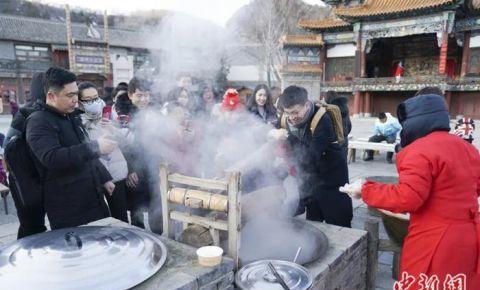The seventh draft of the "New Year's Taste of China" series: What are the similarities and differences between Chinese and Western "temple fairs"?
Beijing, 3 Feb (China News Service) Title: What are the similarities and differences between the "temple fairs" between China and the West?
Author Wang Suning
According to the "Cihai" interpretation, the temple fair, also known as the "temple market", is one of the forms of Chinese markets, which already existed in the Tang Dynasty. Because it is held on temple festivals or on a specified date, it is called a "temple fair". The temple festival activities, which evolved from the serious temple sacrifices, social sacrifices and folk beliefs, showed a colorful picture of life due to the integration of functions such as commerce and pleasure, and became a place for the people to entertain, buy goods and play. Visiting temple fairs during the New Year has become an indispensable custom for Chinese.

In January 2020, the Gubei Water Town Scenic Area at the foot of the Great Wall in Simatai, Beijing, held the "Great Wall Temple Fair for the New Year" activity, where visitors can experience activities such as temple fair markets, folk flower fairs, temple fair snacks, street folk arts, ice sports, open-air hot springs, and night flower lanterns. The picture shows visitors experiencing the suppressed bird noodles. Photo by China News Service reporter Sultan
Although chinese and Western festival traditions are different, the path of finding joy and happiness through festivals is consistent. Western carnivals, Halloween, etc., which also originated from folk culture, are similar to the Chinese Spring Festival temple fairs, have a long history and rich cultural connotations, and are all laborers' own festivals, and these commonalities provide a platform for cultural exchanges.
In October 2019, the Halloween Costume Parade was held in San Francisco, USA, where people wore different styles of costumes to welcome Halloween. Photo by Liu Guanguan, a reporter of the China News Service
According to expert research, temple fairs in the modern sense originated from religious activities in the Sui and Tang dynasties and were perfected and developed in the Ming and Qing dynasties. The temple fair disappeared for a time in the 1950s, and the Ditan Spring Festival Temple Festival held in 1985 created a precedent for large-scale Spring Festival temple fairs in New China because of its colorful cultural activities.
Like the Spring Festival temple fair, Western "temple fairs" such as The Western Carnival and Halloween are derived from religion and have expanded their original connotations in historical development, adding local cultural characteristics and rich and diverse contents. Whether it is a masquerade ball, a float parade, or a mask and a "ghost knocking on the door", it is an extension of its traditional culture and is the epitome and extension of its folk culture.
The Chinese temple fair changes with the times, but also continues to integrate new content, new forms, but the display of folklore is always the most basic background of the temple fair activities, whether it is lion dance, song, martial arts and acrobatics, or local drama, handicraft display, etc., are full of freedom, catharsis of life experience and sensory enjoyment, are in the "imagination and intellectual freedom activities" to obtain happiness, that is, aesthetic pleasure. Therefore, although the chinese and Western "temple fairs" are very different in their expressions, the beauty of their forms and their individual aspirations are the same.
Each ethnic group has a natural environment, economic and political background, historical and cultural traditions, folk customs, behaviors, aesthetic tastes and so on that belong only to its own ethnic group. The national characteristics composed of all these factors are reflected in the temple fair activities, and there is an irresistible penetration of the temple fair form, making it have the beauty of colorful national styles.
In recent years, many local Chinese Spring Festival temple fairs have introduced Chinese culture and its customs and customs overseas, which has been very popular. Many Chinese communities and Chinatowns around the world have large-scale activities during the Spring Festival, mainly dragon and lion dances, costume parades and other performances, supplemented by markets. As an important folk culture phenomenon of the Chinese nation, temple fairs have been gradually incorporated into a stronger and more rational cultural system in the process of globalization, and have great potential in terms of cultural influence.
In February 2019, the 20th New York New Year Love Float Parade was held in Manhattan, New York, to celebrate the Chinese New Year, attracting people of all ethnic groups to watch it. Photo by Liao Pan, a reporter from China News Service
Chinese and Western "temple fairs" all draw nutrients from folk history and culture, of course, they all have historical implications and national characteristics. Temple fair activities reflect the nationalization of folk customs and universal humanity, and are the crystallization of creative talents and spiritual life.
The inheritance, stability and permeability of folk culture determine the stability, stylization and convergence of temple culture, which also makes the two focus on richness and diversity, knowledge and interest, nationality and cosmopolitanism, advanced and novelty, tradition and modernity, and reflect the people's hopes, yearning and pursuit of a better life. (End)
Source: China News Network